Authors: Katharine S. Gries & John Fastenau
Background:
Social media platforms give patients a voice by allowing them to discuss their health and connect with others. These unfiltered and genuine reports offer direct access to what matters most to patients. Exploring the patient-reported outcomes discussed in these platforms reveal clinical insights and behavioral patterns of the real-world patient journey. This research study reviewed health-related quality of life (HRQoL) concepts reported by patients with multiple myeloma (MM).
Methods:
Data were obtained using the Belong.life patient-powered research network (PPRN) using social media listening methods. The analysis cohort consisted of adults diagnosed with MM who signed into the Belong.life platform by June 2018. Natural language processing and medical neural networks were utilized to extract text data to mine and scan for concepts using programmed algorithms. The textual review of the data was conducted on two levels: the over-arching concept of interest (broad symptom and impact classification) and the more specific symptom and impacts report. Concepts were analyzed descriptively and summarized by age, gender, context of report, and stage of disease/treatment journey.
Results:
Two hundred thirty patients with MM from the United States (52%), Israel (42%), Canada (3%), and 3% from Egypt, France, Greece, India, United Kingdom, and Australia were identified. A total of 57% were female and at account registration the median age was 57 years. A total of 126 patients had evaluable text data to search concepts being discussed. The PPRN platform identified 93% of the concepts from the conceptual model developed based on prior literature review. The most commonly reported symptoms were neuropathy, tiredness, nausea, back pain, fatigue, and bone pain. Back pain appeared as the most prominent symptom early in the disease and sometimes occurred prior to MM diagnosis. Tiredness, nausea, fatigue, and bone pain were frequently reported after MM diagnosis, with the start of treatment.
Conclusion:
Patient-oriented social media platforms, such as Belong.life, can capture and contribute to a holistic vision of concepts surrounding patients’ HRQoL. The ability to understand when a certain debilitating symptom appeared and to which sub-population of patients may allow for a personalized approach to treatment, improving adherence and quality of care as well as increasing patient well-being.
For more info: Using a digital patient powered research network to identify outcomes of importance to patients with multiple myeloma








